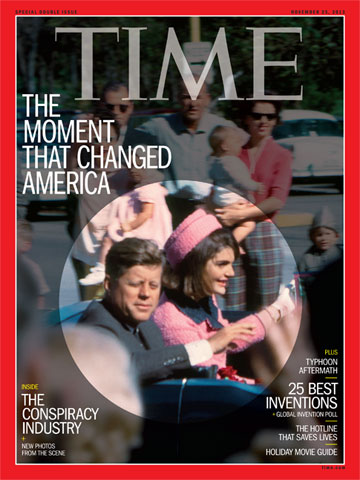
(3 of 8)
Late in the morning of Nov. 22, John and Jacqueline Kennedy landed in this toxic milieu. They had started the day in nearby Fort Worth under a gray and rainy sky, but as the presidential jet dropped into Dallas, the sun broke through. This happened so often that White House aides and the traveling press called it "Kennedy weather." And when the sun smiled like this, the President liked to ride with the top off his limousine and the rear seat raised so that people could see him easily.
Plans called for a motorcade along Main Street through downtown Dallas. Hardly a trace of right-wing protest was seen: scattered leaflets accused the President of treason, and the Morning News published an advertisement hostile to Kennedy, but this paled beside the cheering crowds that packed the motorcade route. The First Lady beamed in her smart pink suit and matching pillbox hat. Connally, seated in front of the President, slightly lower and to the left, no doubt calculated that having Kennedy on the same ballot was less dangerous to his re-election prospects than he had feared.
At the edge of downtown, where the motorcade might have picked up speed, Kennedy's limousine instead slowed to a crawl, making a right turn followed by a hard left around a plaza named for the father of the Morning News publisher. The clock on top of the Texas School Book Depository said 12:30. Standing on a concrete post beside the plaza, steadying his 8-mm movie camera, was a Russian immigrant named Abraham Zapruder, whose clothing business had its headquarters in a nearby building. He activated the camera at about the same time that he heard the first of what he later said were two or three gunshots. What happened during the 26.6 seconds that his camera ran gave him nightmares, in which he envisioned his film playing at a Times Square smut house under the marquee see the President's head explode!
In the final frames of Zapruder's 486-frame film, he captured the last steps of Secret Service agent Hill's desperate sprint from the running board of a trailing limo to the back of the presidential car. Not seen was Hill's scramble across the trunk lid to press the First Lady back into her seat. As he shielded her with his body, he saw that Nellie Connally was cradling her bleeding husband, who was wounded in the torso and wrist, while in the back seat the President slouched in a pool of gore. Signaling to the car behind, Hill turned his thumb down in a hopeless gesture. The motorcade sped onto a freeway and headed for the nearest hospital.
Already, I've passed the point in this story where the facts are widely accepted. From here on, very little can be said that will not be disputed by someone with another version of events. For the shock that registers in frame 313 of the Zapruder film jarred loose a welter of conflicting testimony and a jumble of poorly considered actions.
Eyewitnesses in the plaza could not agree on the number of gunshots or where they came from. Employees inside the book depository, which loomed over the Elm Street crime scene, could not agree when--or whether--they had seen their co-worker Lee Harvey Oswald hustling down the stairs.
